Loie Fuller had only a modest talent as an actor and burlesque dancer, but she came up with one brilliant stage idea and it made her internationally famous. In 1891 she began to experiment with the possibilities of amplifying and transforming her dancing with gorgeously coloured swaths of silk, and over the years perfected the technique of manipulating the fabric so that her weaving, spiralling movements created images of flowers, butterflies and flames. A radical innovator in stage lighting and design, Fuller also experimented with colour gels and chemical salts to give an extra phosphorescent glow to her creations.
Fuller’s signature act, The Serpentine Dance, became so popular that it was widely imitated, to the point that other dancers tried performing it on stilts, on horseback or even in a cage with lions. As Marketa Uhlirova’s 2013 book, Birds of Paradise: Costume as Cinematic Spectacle, reveals, the dance was also a source of fascination to early film-makers, including the Lumière brothers, Alice Guy and Segundo De Chomón, who experimented with shooting it in different ways, multiplying the dancing image, hand-colouring and stencilling the fabric with different tints.
But as Uhlirova’s book also argues, Fuller’s concept of costume-as-performance had a further-reaching effect. In a series of essays, illustrated with a fabulous gallery of images, Birds of Paradise cites example after example of dress taking centre-screen in works of the early cinema. There’s Theda Bara in a cascading floor-length gown made entirely of peacock feathers; Betty Blythe wearing a dress constructed of pearls; Alla Nazimova dwarfed by a towering feathered headdress as Salome, and Lilyan Tashman in a dress designed by Erté to resemble a giant perfume bottle.

Fantasy and spectacle ran brilliantly and expensively amok, and Uhlirova traces this concept of performative costume up to the queer cinema of the 1960s. Another variation, of course, can be seen in the surreal self-promoting outfits of Lady Gaga.
And yet another can be seen in the remarkable “career” of the Marchesa Luisa Casati who, from 1910, dedicated her life, and her enormous fortune, to the project of transforming herself into a living work of art. An exhibition currently running at the Fortuny museum in Venice traces how Casati – moving between the capital cities of Europe – commissioned designers to make her every appearance a theatrical event. She started with Mariano Fortuny himself, wearing one of his brocade velvet cloaks in her daily perambulations around Piazza San Marco, accompanied by a tall, black servant who both held up a feathered parasol to shelter her from the sun and also maintained control of her two pet cheetahs, decorated with jewelled collars and, rumour has it, tamed with small doses of opium.
She tinted her hair with red henna and dramatised her eyes with belladonna, kohl and two-inch-long, false lashes. As her ambitions grew more extreme, Casati moved on to Leon Bakst (designer for Diaghilev’s Ballets Russes), who outfitted her variously as a Persian princess, a gilded sun goddess and a harlequin; and to Paul Poiret who created an exquisite “fountain dress” made from delicate tiers of pearls and wire.

Some of these costumes she wore to her own grandiose parties. But Casati was said to have attended the Paris Opera in a dress of swan’s feathers or with fresh chicken’s blood daubed over one arm; to have dined with a pair of golden ram’s horns attached to her temples; to have partied with her pet boa constrictor draped around her shoulders; to have dressed for a ball as Saint Sebastian, wearing armour pierced with dozens of illuminated arrows – a project that was stymied when faulty wiring gave her an electric shock.
Casati also commissioned dozens of artists to record her transformations, including Man Ray, Jacob Epstein, Romaine Brooks and Augustus John. Like Fuller, she captured the fantasy of an era. And while Casati didn’t appear on the professional stage, Serge Diaghilev – always a master of publicity – did try to cast her in a mime role in one of his 1914 Ballets Russes productions, and three years later she was the dedicatee of Marinetti’s Manifesto of the Futurist Dance.

There was, perhaps, some vanity in her project, certainly a catastrophic disregard for money. But Casati, whose life I’ve been researching for a book of my own, liked to consider herself an artist and she had the pure, intense focus of an obsessive. Like Fuller (with whom she had some links), her influence has been extensive: in 1998, John Galliano designed an entire season around her astounding profligacy of image, and it’s been argued that some of the screen goddesses showcased in the Uhlirova book were also indebted to her remarkable, extravagant capacity for self-invention.
Birds of Paradise: Costume as Cinematic Spectacle, by Marketa Uhlirova, published by Walther König

Comments (…)
Sign in or create your Guardian account to join the discussion